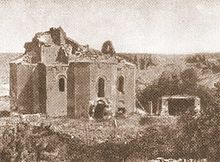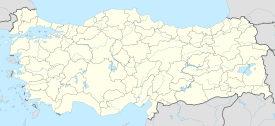Bagaran (ancient city)
Բագարան | |
 Saint Theodore Church of Bagaran, before 1923 | |
| Location | Partly on the site of the Turkish village of Kılıttaşı near the border with Armenia, Kars Province, Turkey |
|---|---|
| Coordinates | 40°12′06″N 43°39′17″E / 40.20167°N 43.65472°E |
| History | |
| Builder | King Orontes IV of Armenia |
| Founded | 3rd century BC |
| Abandoned | 1394 |
Bagaran (Armenian: Բագարան) was a city in ancient Armenia founded during the reign of the Orontid dynasty. It is one of the historical capitals of ancient Armenia.[1]
History
Ancient and medieval
According to the Armenian historian Movses Khorenatsi, Bagaran was founded during the third century BC by King Orontes IV of Armenia.[2] It quickly became the religious centre of Armenia, replacing Armavir as the main spiritual site of the Orontid pagan temples.[3] After the fall of the Orontid dynasty and the rise of the Artaxiad dynasty, king Artaxias I moved all the pagan monuments from Bagaran to his newly built capital of Artashat (Artaxata), founded in 176 BC.

During the second half of the sixth century, Bagaran, along with the entire canton of Arsharunik, became the property of the Kamsarakan princes. The Church of Saint Theodore built between 624 and 631 was one of the main landmarks of Bagaran. Inscriptions on the church of Saint Theodore of Bagaran were located at the exterior of the entire building, starting at the northern face of the western apse and running across the northern, eastern and southern faces.[4]
The Bagratunis took over the city during the eighth century. In 895, after the establishment of the Kingdom of Armenia, Bagaran became the capital of an independent Armenian kingdom under Ashot I. His successor, Smbat I, moved the capital Bagaran to Shirakavan in 890. Under Bagratid rule, Bagaran remained one of the prosperous centers of the Armenian kingdom. Many Bagratuni rulers, including Ashot I, are buried in Bagaran.[5]
However, in 1045, Bagaran, along with the Armenian capital of Ani, was invaded by the Byzantines. In 1064, the city was attacked and heavily destroyed by the Seljuk Turks. During the twelfth century, the Shah-Armens took over Bagaran. In 1211, Bagaran was briefly ruled by the Zakarid princes of Armenia before being invaded by the Mongols in 1236. In 1394, Bagaran was finally destroyed by Tamerlane.[6]
Modern
At the beginning of the twentieth century, there was an Armenian-populated village near the site of ancient Bagaran with a population of slightly over 300. In 1920, as a result of the Turkish–Armenian War, the territories of the Republic of Armenia located west of the Akhurian River were captured by Turkey. The small group of the Armenian survivors of Bagaran crossed the river to the eastern bank and founded the modern village of Bagaran within the Armenian SSR, just 8 km south of the site of the ancient city. Nowadays, a small Kurdish-populated village called Kilittaşı partially lies on the ruins of Bagaran, on the Turkish side of the closed border.
According to the Armenian historian Joseph Orbeli, the Church of Saint Theodore of Bagaran was one of the most prominent examples of early medieval Armenian architecture. It was largely intact until 1920. However, it was deliberately destroyed by the Turkish authorities.
References
- ^ Hakobyan, Tatul. "After years of isolation, the ancient capitals of Yervandashat and Bagaran are now open to visitors Archived 2014-12-18 at the Wayback Machine." Armenian Reporter. April 10, 2009.
- ^ Hewsen, Robert H., "Bagaran Bagaran." Iranica.
- ^ Armenian encyclopaedia
- ^ (in Russian) Orbeli, Joseph, Избранные труды. Yerevan, 1963, p. 390.
- ^ Manuk-Khaloyan, Armen, "In the Cemetery of their Ancestors: The Royal Burial Tombs of the Bagratuni Kings of Greater Armenia (890-1073/79)," Revue des Études Arméniennes 35 (2013): pp. 134-42.
- ^ Bagaran, one of the 13 capitals of Armenia

